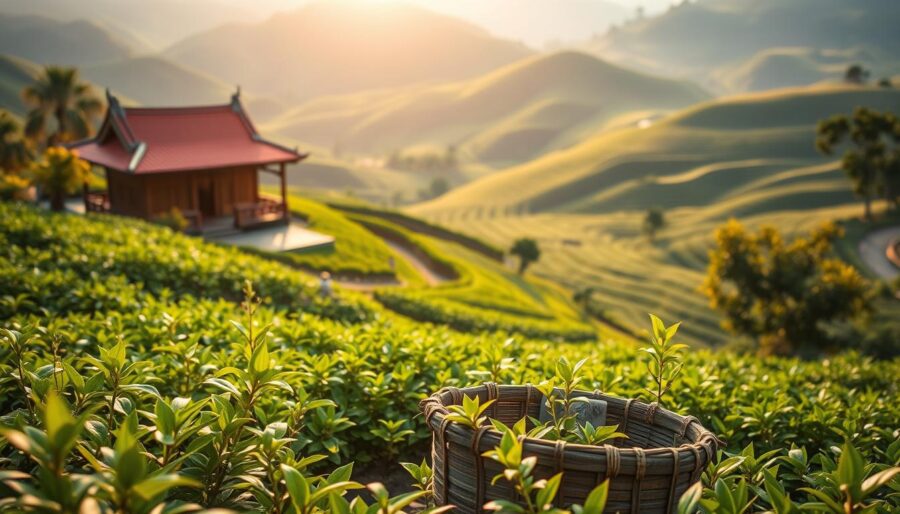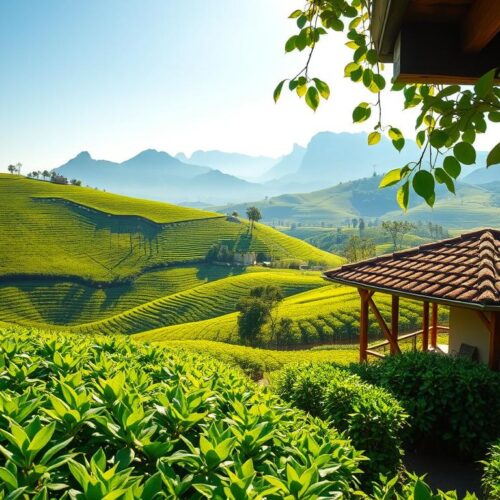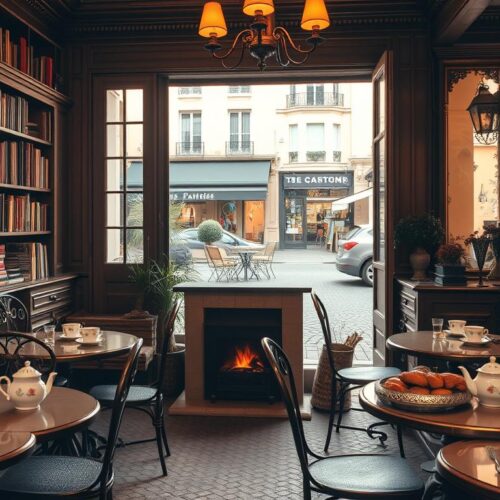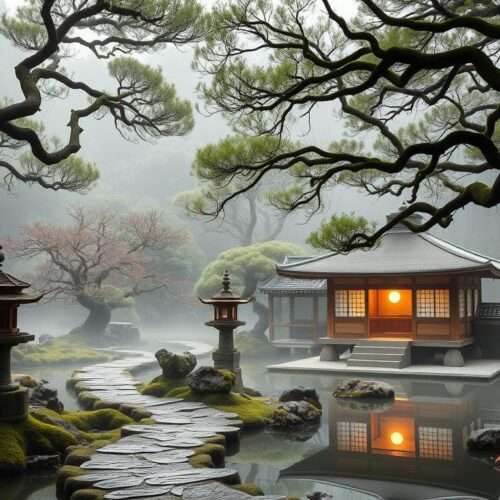Welcome to the enchanting world of Vietnamese tea culture. Every cup has a rich history and tradition behind it. This tea culture has grown over centuries, influenced by Vietnam’s varied landscapes and rich cultural exchanges.
Here, tea is not just a drink; it’s a symbol of hospitality and community. You’ll experience a variety of unique flavors, from the fragrant green tea to herbal infusions. These serene rituals welcome you to relax and enjoy the moment.
Exploring the tea houses in Vietnam opens up a world of inviting atmospheres. This ancient practice is a hidden gem full of stories, waiting to be discovered by you.
The Origins of Tea Culture in Vietnam
Vietnamese tea history stretches back over a thousand years, deeply rooted in the country’s traditions. Tea first came to Vietnam during the Tang dynasty, forever changing the nation’s cultural landscape. This wasn’t just about drinking tea; it turned into an essential aspect of daily life, shaping social customs.
Tea rituals started to form, becoming a key part of important ceremonies and social events. Meanwhile, tea trade routes in Vietnam opened up, allowing for the exchange of ideas and tea flavors with nearby countries. These routes helped introduce different tea types and methods, creating a distinct Vietnamese tea culture. As tea became popular all over Vietnam, it varied according to local tastes, yet remained a strong symbol of hospitality and tradition.
The deep connection between Vietnamese tea history and its cultural value highlights how tea is not just a beverage. It’s a fundamental part of Vietnamese identity, treasured across generations. By exploring these origins, we uncover the deep bond between the people and their beloved tea.
Different Types of Vietnamese Tea
Vietnam offers a wide variety of teas that reflect its varied landscapes and weather. Green tea from Vietnam is especially beloved for its fresh, light taste. It’s a favorite everyday drink for many people there. The Thai Nguyen area is known for producing green tea that’s fresh and aromatic. The special qualities of this region’s soil and climate make the tea unique.
Herbal teas are also an important part of Vietnam’s tea culture. These teas are not only tasty but are believed to have health benefits. Lotus and jasmine teas are two well-known herbal teas. Lotus tea is made by scenting green tea with lotus flowers, creating a calming drink with gentle floral hints. Jasmine tea mixes green tea with jasmine flowers for a scent-filled and flavorful brew.
The Art of Brewing Vietnamese Tea
Brewing Vietnamese tea is much more than making a drink. It’s a deep art that carries a rich cultural history. The traditional way of making tea focuses on blending flavors and smells. This approach creates an experience that captures the essence of Vietnam. Every step, from picking the tea leaves to presenting the final product, is important.
Tea brewing tools are key in this tradition. Special teapots and brewing vessels help get the right flavor. For example, a clay teapot can make the tea smell and taste better, giving it a unique touch. Other items like tea filters and cups are also vital. They ensure every cup of tea is a work of art.
When you brew tea the traditional way, take time to enjoy the process. Each brewing moment is a chance to connect with a long tea tradition. It lets you see the care put into making Vietnamese tea so special. Whether you’re new to this art or have been doing it for years, knowing the tools and methods adds to the enjoyment of each sip.
Tea and Vietnamese Cuisine
Tea is very important in Vietnamese food, making flavors richer and smells better. It’s loved for making meals special in Vietnam. Tea goes well with different foods, making every bite better.
At home, sharing tea shows kindness and tradition. It’s not just a drink, but a way to bond with others. Jasmine tea is great with light meals like spring rolls. Green tea matches well with grilled dishes. These combinations highlight the variety in Vietnamese dishes and tea.
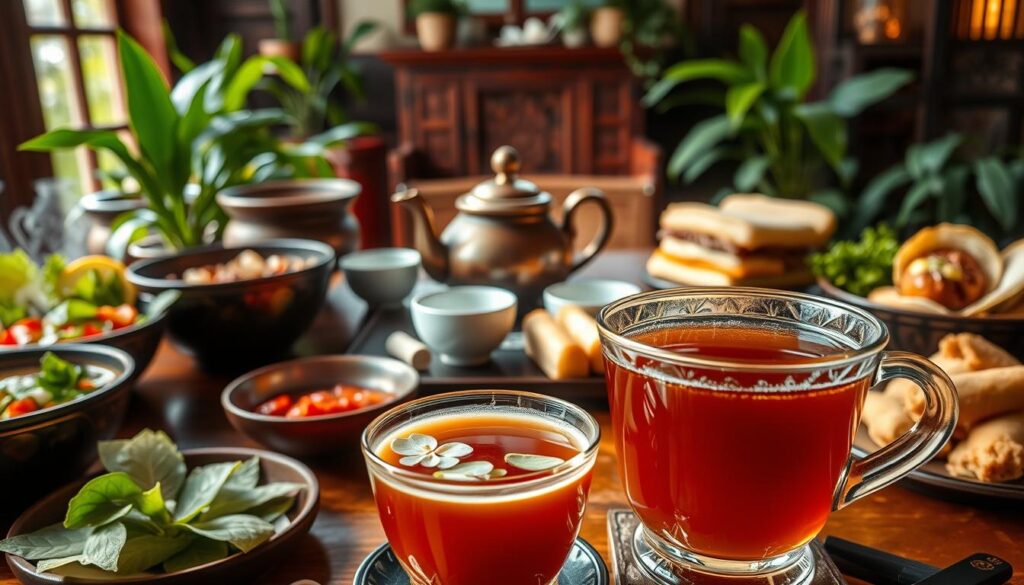
Discovering Vietnam’s food scene, you’ll see how tea makes meals more enjoyable. Its cultural value and ability to improve taste turn dining into a flavor fest.
Regional Variations in Tea Culture
In Vietnam, tea culture varies a lot between the North and South. Each area has its own way of doing things, showing the impact of their specific weather and land.
The North likes its tea strong, thanks to the cool weather. Teas here are full of deep, earthy flavors. Favorites include green tea from Mien Trung and aromatic lotus tea. These teas are often shared during meals or social gatherings, adding to the moment.
Down South, the approach to tea is lighter and full of flower scents. Jasmine and chrysanthemum teas are the stars. They come with a hint of sweetness, perfect for the South’s love of gentle and refreshing tastes. Tea in the South goes beyond a drink—it’s part of welcoming guests.
When you learn about these differences, you understand Vietnamese tea better. It’s a window into how places and traditions influence tea enjoyment across the country.
| Characteristic | Northern Tea Traditions | Southern Tea Practices |
|---|---|---|
| Climate Influence | Cooler, leading to robust flavors | Warmer, favoring lighter and floral blends |
| Popular Tea Types | Green tea, lotus tea | Jasmine tea, chrysanthemum tea |
| Flavor Profile | Earthy, bold | Floral, sweet |
| Social Settings | Accompanies meals, gatherings | Symbol of hospitality, relaxing occasions |
The Ritual of Tea Ceremonies
Vietnamese tea ceremonies are deeply meaningful and show the importance of social interactions during key life events. These gatherings celebrate milestones and honor age-old traditions, showing respect for tea’s cultural heritage. The choice of tea is crucial. It emphasizes the quality and scent, fostering strong bonds between people.
The set-up of these ceremonies includes decorative items and special tools that add to their beauty. Tea pots and cups, crafted with care, sit among vibrant flowers, creating a captivating scene. This setting allows guests to see the host’s skills and the value placed on welcoming others.
Etiquette plays a big role in these rituals. Every action is guided by rules that show respect. The eldest person often receives tea first, which shows the importance of rank and relationships. Talking with others during the event helps everyone feel more connected and appreciates the ceremony more.
The Modern Revival of Vietnamese Tea
The growing interest in Vietnamese tea today is interesting. It shows how traditions and new ideas are coming together. People looking for real experiences are turning to tea companies that offer both artisan and classic teas. They discover blends that link the old with the new, reflecting broader changes in the global tea industry.
On social media, tea culture is getting a lot of attention. Sites like Instagram and TikTok are great for sharing tea stories, recipes, and tips. Influencers share how to make tea, talk about different tastes, and where the teas come from. Their posts, which look good, draw in new people, making them curious about Vietnamese tea culture.
With more people checking out these online posts, interest in Vietnamese tea grows, boosting the demand for top-notch teas. Small companies start up and use social media to find buyers. This excitement about new Vietnamese tea shows a lasting love for this old drink, now enjoyed by the next generation.
Health Benefits of Drinking Vietnamese Tea
Vietnamese tea has many health benefits that improve your wellness. The country’s tea culture offers more than just taste; it feeds the body, too. Green tea from Vietnam is known for its antioxidants which are key for health.
In Vietnam, green tea is popular and very healthy. Studies show its antioxidants can fight off body-damaging free radicals. This supports your immune system and might lower the risk of heart disease and diabetes.
Besides green tea, there are herbal teas made from local plants. These teas can heal, targeting certain health issues. For example, lotus tea can relax you, while ginseng tea boosts energy and brain power.
Having Vietnamese tea regularly has many pluses:
| Type of Tea | Key Health Benefits |
|---|---|
| Green Tea | Rich in antioxidants, supports heart health, aids in weight loss |
| Lotus Tea | Calming effects, helps with sleep quality |
| Ginseng Tea | Boosts energy, enhances cognitive function |
| Jasmine Tea | Rich in antioxidants, promotes relaxation, improves mood |
Learning about Vietnamese tea makes you want to try them. Adding these teas to your routine could make you healthier. It’s a natural way to care for yourself in today’s world.
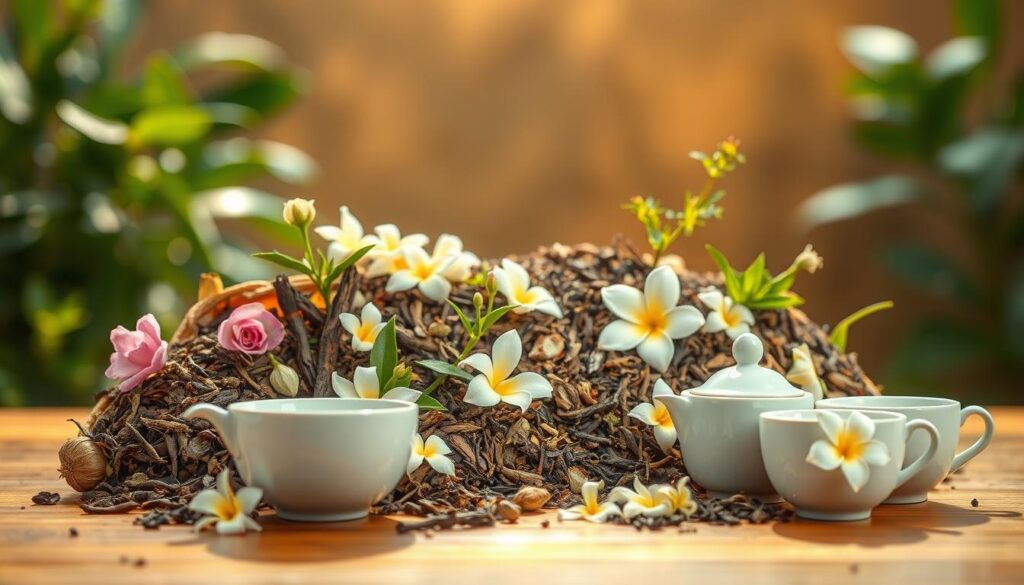
Vietnamese Tea Etiquette
Learning about Vietnamese tea etiquette is key to fully enjoying their drinking traditions. The way tea is part of daily life and social events in Vietnam is special. For them, tea symbolizes hospitality, welcoming anyone and strengthening bonds.
If someone offers you tea, it’s polite to accept it with thanks. They usually serve tea in a small cup and it’s polite to fill your visitor’s cup before your own. This shows respect and care for their comfort.
Here are some key customs to remember:
- Holding the cup with both hands is a sign of respect.
- Don’t put your cup back on the table empty; leave a little tea.
- Always offer tea to others before pouring some for yourself.
Here’s a table that sums up the most important points of tea etiquette in Vietnam:
| Action | Significance |
|---|---|
| Accepting tea with both hands | Shows respect and appreciation |
| Refilling guest’s cup first | Demonstrates hospitality in tea culture |
| Leaving a sip in your cup | Indicates that you enjoyed the drink |
Following these traditions will help you act respectfully and skillfully in social situations that involve drinking tea in Vietnam.
Exploring Tea Plantations in Vietnam
Your journey through Vietnamese tea plantations takes you to the heart of the country’s rich traditions and agricultural practices. Key tea regions in Vietnam include Thai Nguyen and Lam Dong. These areas have lush landscapes and favorable climates, perfect for tea cultivation. Here, local farmers use their deep knowledge to grow high-quality tea. They create unique flavors that show the true spirit of their land.
Farmers put a big focus on growing tea in a way that’s good for the earth. They use farming methods that improve the tea and also protect our planet. By picking organic farming, they cut down on bad chemicals. This care makes sure your tea is clean and helps keep the earth rich and water clean for others in the future.
The following table highlights some notable features of the Vietnamese tea regions.
| Region | Specialty Varieties | Sustainable Practices | Climate |
|---|---|---|---|
| Thai Nguyen | Green Tea | Organic fertilizers, natural pest control | Tropical monsoon climate |
| Lam Dong | Oolong Tea | Water conservation methods, shade-grown tea | Highland climate, cooler temperatures |
| Ha Giang | Black Tea | Intercropping, agroforestry | Temperate climate |
Exploring these plantations lets you see the farmers’ hard work up close. Walking through the fields, the smell of fresh tea leaves surrounds you. This experience helps you understand all the steps that make Vietnamese tea special. It makes you cherish each sip even more.
Events and Festivals Celebrating Tea
Vietnam has many exciting events focused on tea culture. These festivals show the country’s deep love for tea and its importance in everyday life. You will find big and small festivals that everyone can enjoy.
At a Vietnamese tea festival, you’ll dive into the art of tea. You’ll try different teas, learn how to brew them, and see traditional tea tools. People who love tea share their skills with you, helping you learn about various types of tea.
These events also bring people closer together. You’ll see how tea ceremonies link everyone to Vietnam’s long-standing traditions. It’s a chance to experience Vietnamese warmth and learn about their customs.
The National Tea Festival is one big event to look out for. Tea enthusiasts from everywhere come to enjoy it. They share stories and techniques, making it perfect for those who love tea culture.
Going to these tea festivals lets you really connect with Vietnamese culture. You’ll taste incredible teas and feel the sense of community they bring. It’s a wonderful way to experience Vietnam’s rich heritage.
Tips for Enjoying Vietnamese Tea at Home
To bring the authentic taste of Vietnamese tea home, begin with sourcing real teas like green, lotus, or jasmine tea. Find reliable shops that offer Vietnamese teas. They should preserve the true spirit of Vietnam’s tea culture. Always check the labels for teas from known areas like Thai Nguyen or Lam Dong. These places are celebrated for their tea quality.
After picking your teas, learn the right way to make Vietnamese tea. Use pure, filtered water and be mindful of the water temperature—around 80-85°C (175-185°F) for green tea is ideal. Let the tea steep for a few minutes to unlock its full aroma. Try different brewing times until you find the taste that brings you to a traditional tea house.
Then, set up a calm place to enjoy your tea. You might pair it with traditional snacks or enjoy it quietly. Following these steps, you can discover Vietnamese tea at home. This journey enhances your connection to an ancient culture.

